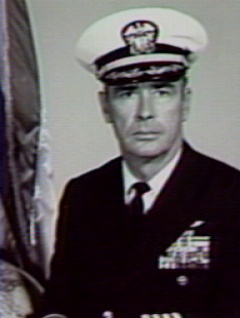CHANDLER-ALFRED
ALFRED WHITE "HAP" CHANDLER JR.

CAPT

Alfred White Chandler Jr. was born on December 15, 1923. He earned an appointment to the U.S. Naval Academy where his father was a Rear Admiral and the Senior Dentist on the campus. Much to his father’s disappointment, young Chandler instead enlisted in the Navy ln June 1941 and following boot camp was accepted into the Navy’s Aviation Cadet Program where he earned his wings in 1942. He was sent to the Pacific as a replacement pilot in fighter squadrons VF-1 and VF-5 aboard the USS YORKTOWN, and to VF-13 aboard USS FRANKLIN. Aboard FRANKLIN he had the dubious distinction of being blown out of his plane when a Japanese kamikaze struck the carrier. Chandler saw considerable action as he flew at Truk, Palau, Hollandia, Clark Field in the Philippines (where he was credited with shooting down a Japanese fighter), Saipan, Rota, Guam, Okinawa and the Mariana Islands. A highlight of his Navy career included a tour as the first American exchange pilot with the Royal Navy, flying jet fighters with 803 Squadron aboard the HMS EAGLE. During this tour he survived a ditching in the English Channel. He also had tours as a test pilot at the Naval Air Test Center in Patuxent, Maryland, as Commanding Officer of VF-114 aboard USS KITTY HAWK, as Navigator on the USS TICONDEROGA and as Commanding Officer of Detachment Charlie in Saigon where he coordinated operations between the Seventh Fleet and the Seventh Air Force. He was also Commanding Officer of Naval Air Station Miramar in California when it was home to the Navy’s famous TOPGUN Fighter Weapons School. Captain Chandler retired from the Navy in 1974 after 33 years of service and was particularly proud of being a member of the Golden Eagles, an elite group of distinguished pioneer Naval Aviators.
The following are excerpts about a 1950 incident written by an associate describing an incident in CAPT Chandler’s life when he was a Navy test pilot:
“He was assigned for Test Operations for the F6U-1 at Ardmore, Oklahoma. In preparing for a test flight one of the procedures that I always did was to strap the pilot into the seat and review the objectives of the test flight. Hap Chandler was the Navy Flight Test Pilot on this check flight. Chandler and I had worked together for some time, were good friends and he had been test flying many different types of airplanes. While strapping him in I ask him if he had read the Pilot’s Handbook for the F6U. Chandler assured me that he had read the Hand Book and that he knew the objectives of the check flight. Chandler began to taxi out to the end of the runway. I went into the radio shack where another pilot and I established radio contact with him. The radio shack was located to the side and about half way down the runway. Past experience had shown that the wheels should be off the ground at that point in order to clear the mountain located just off the end of the runway. At that time there were three of us on the field, a pilot in the shed with me and Chandler in the airplane. Chandler began his take off run. He kept coming along the runway at full power and raced by and on toward the mountain side. Suddenly the airplane went vertical in a very sharp 90 degree change in direction! We were screaming into the mike, ‘Chandler, Chandler, is everything ok?’ He did not answer for a long time. Finally he said ‘Whew!!’. Chandler said that when he realized that something was wrong he looked down at the stick and saw that his glove between his thumb and his index finger had gotten caught in the trim tab wheel and had fed in nose down trim. He reached down with his other hand and jerked his glove out of the wheel and immediately the aircraft went vertical! The action of removing his glove from being caught in the trim tab fed in enough nose up trim to cause the sudden 90 degree pitch up. It is fortunate that he did not break his neck or damage the aircraft. He immediately came back and landed and when he got out of the airplane his flying suit was sopping wet. All three of us were shaking from the experience. Fortunately no one was hurt, nothing was damaged and the aircraft was in good shape.”
/s/ H. J. MERBLER
Submitted by CDR Roy A. Mosteller, USNR (Ret)

